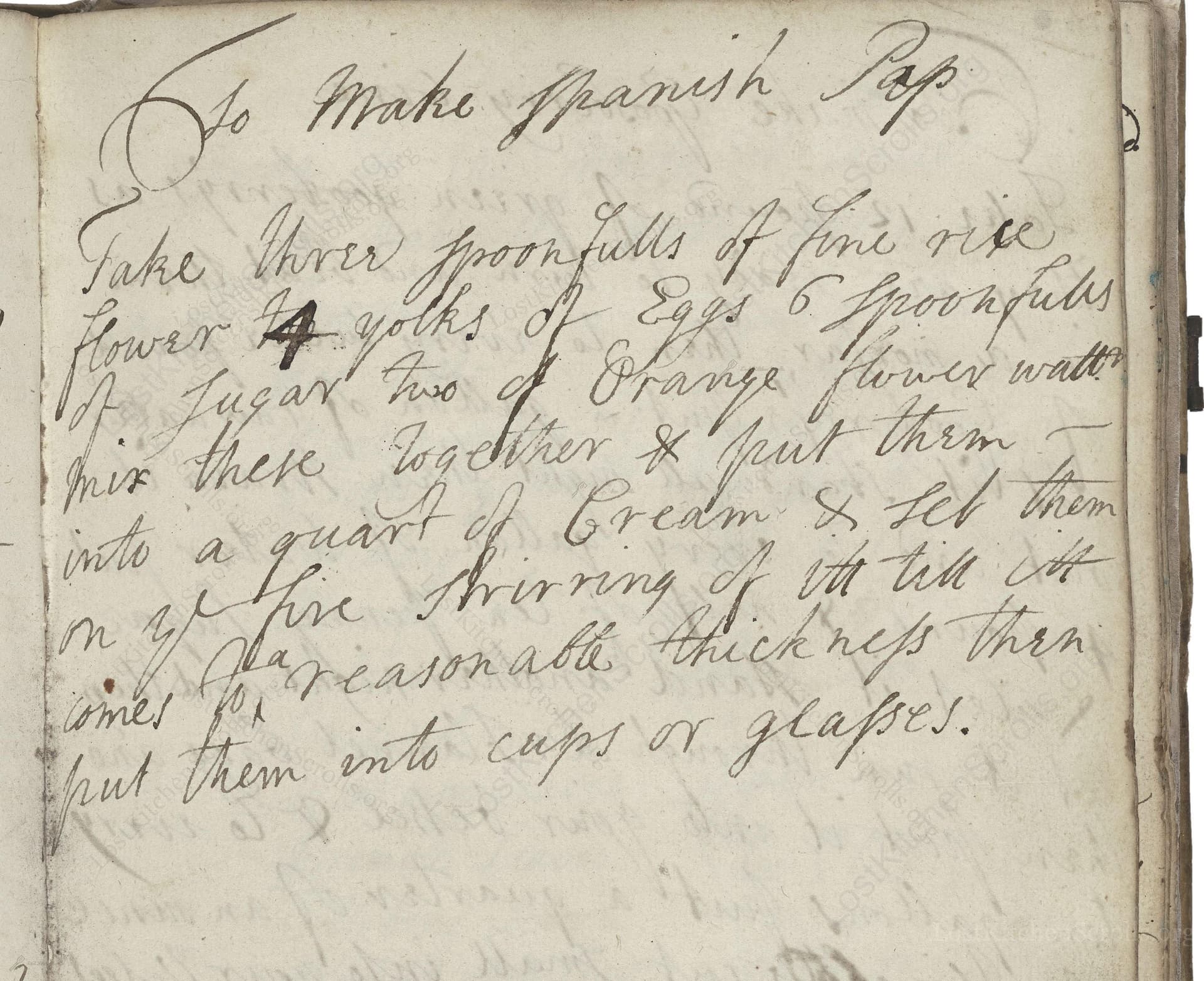To Make Spanish Pap
From the treasured pages of Cookery and medicinal recipes of the Granville family from Worcestershire and Cadiz
Written by Granville family

To Make Spanish Pap
"Take three Spoonfulls of fine rice Flower 4 yolks of Eggs 6 Spoonfulls of Sugar two of Orange flower watter mix them together & Put them into a Quart of Cream & Set them on y fire Stirring of itt till itt Comes for a reasonable thickness then Put them into Cups or glasses."
Note on the Original Text
This early modern recipe is written in a minimal, flowing style, typical of manuscript cookery collections. Spelling is inconsistent ('flower' for 'flour', 'watter' for 'water', 'itt' for 'it'), and punctuation is sparse or absent. Quantities are given by the spoonful and quart—household measures that required the cook’s judgment and experience. Instructions assume knowledge of basic cookery techniques, so key steps like the exact degree of thickening are left to the reader’s familiarity with the kitchen. The recipe is direct but relies on intuitive, hands-on understanding—a delightful challenge for any historical cook!

Title
Cookery and medicinal recipes of the Granville family from Worcestershire and Cadiz (1695)
You can also click the book image above to peruse the original tome
Writer
Granville family
Era
1695
Publisher
Unknown
Background
A delightful journey through the culinary traditions of the Granville family, this historical recipe collection serves up a taste of English kitchens from the 17th and early 18th centuries. Brimming with time-honored techniques and flavors, it invites modern readers to savor the spirited inventiveness of early modern home cooks.
Kindly made available by
Folger Shakespeare Library
This recipe comes from the Granville family manuscript, dating roughly from 1640 to 1750. The English aristocracy of this period frequently collected fashionable international recipes, and 'Spanish Pap' reflects the era’s fascination with delicate, lavishly flavored custards and creams inspired by Continental, especially Spanish, influences. Custards thickened with rice flour and perfumed with exotic floral waters were considered luxurious, demonstrating both wealth and culinary sophistication in the early modern English household. The use of orange flower water situates the dish firmly within a cosmopolitan context; such floral essences were imported and highly prized. This pap would have served as an elegant dessert or restorative snack, perhaps enjoyed in fine cups alongside other dainty sweetmeats.

In the 17th and 18th centuries, this recipe would have been made using a large earthenware or copper saucepan set over a gentle fire or placed on the hearth. A wooden spoon or whisk would have been used for stirring continuously to prevent curdling and ensure a smooth texture. The mixture would then be ladled into porcelain or glass cups—signs of status in themselves—to cool. No thermometers, just a careful watch on the thickness and heat!
Prep Time
10 mins
Cook Time
10 mins
Servings
6
We've done our best to adapt this historical recipe for modern kitchens, but some details may still need refinement. We warmly welcome feedback from fellow cooks and culinary historians — your insights support the entire community!
Ingredients
- 1 ounce fine rice flour (or substitute with ground rice)
- 4 egg yolks
- 2.6 ounces white sugar
- 1 fluid ounce orange flower water (or, if not available, a few drops of orange extract as a substitute)
- 1 quart heavy cream (or full-fat milk as a lighter alternative)
Instructions
- To make Spanish Pap, begin by mixing 3 tablespoons (about 1 ounce) of fine rice flour, 4 egg yolks, 6 tablespoons (about 2.6 ounces) of white sugar, and 2 tablespoons (about 1 fluid ounce) of orange flower water in a bowl.
- Whisk these together until smooth.
- Gently warm 1 quart of heavy cream (or substitute with a rich whole milk) in a saucepan over medium heat.
- Gradually add the rice flour mixture into the warm cream, stirring continuously.
- Keep stirring as the mixture gently thickens to a custard-like consistency—this should take about 8–12 minutes.
- Once thickened, pour the pap into cups or serving glasses and allow to cool slightly before serving warm or at room temperature.
Estimated Calories
420 per serving
Cooking Estimates
You'll spend about 5–10 minutes preparing the ingredients and 10 minutes cooking the pap until it thickens. Each serving will be rich and slightly sweet.
As noted above, we have made our best effort to translate and adapt this historical recipe for modern kitchens, taking into account ingredients nowadays, cooking techniques, measurements, and so on. However, historical recipes often contain assumptions that require interpretation.
We'd love for anyone to help improve these adaptations. Community contributions are highly welcome. If you have suggestions, corrections, or cooking tips based on your experience with this recipe, please share them below.
Join the Discussion
Rate This Recipe
Dietary Preference
Culinary Technique
Occasions

Den Bockfisch In Einer Fleisch Suppen Zu Kochen
This recipe hails from a German manuscript cookbook compiled in 1696, a time whe...

Die Grieß Nudlen Zumachen
This recipe comes from a rather mysterious manuscript cookbook, penned anonymous...

Ein Boudain
This recipe comes from an anonymous German-language manuscript cookbook from 169...

Ein Gesaltzen Citroni
This recipe, dating from 1696, comes from an extensive anonymous German cookbook...
Browse our complete collection of time-honored recipes



